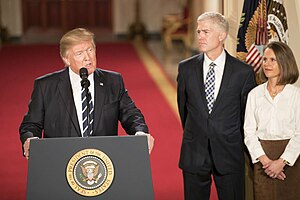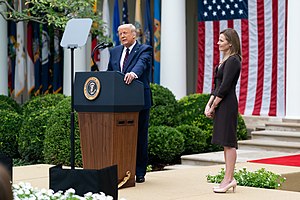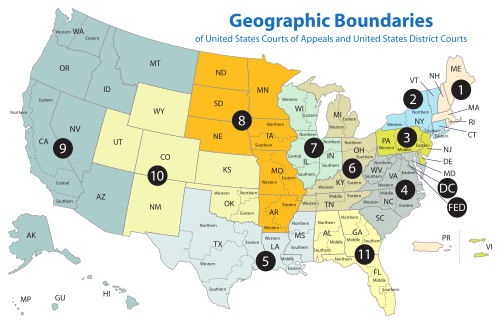
The Supreme Court of the United States (SCOTUS) is the highest court in the federal judiciary of the United States. It has ultimate appellate jurisdiction over all federal court cases, and over state court cases that involve a point of U.S. Constitutional or federal law. It also has original jurisdiction over a narrow range of cases, specifically "all Cases affecting Ambassadors, other public Ministers and Consuls, and those in which a State shall be Party." The court holds the power of judicial review, the ability to invalidate a statute for violating a provision of the Constitution. It is also able to strike down presidential directives for violating either the Constitution or statutory law. However, it may act only within the context of a case in an area of law over which it has jurisdiction. The court may decide cases having political overtones, but has ruled that it does not have power to decide non-justiciable political questions.
Leonard Anthony Leo is an American lawyer and conservative legal activist. He was the longtime vice president of the Federalist Society and is currently, along with Steven Calabresi, the co-chairman of the organization's board of directors.

The demographics of the Supreme Court of the United States encompass the gender, ethnicity, and religious, geographic, and economic backgrounds of the 116 people who have been appointed and confirmed as justices to the Supreme Court. Some of these characteristics have been raised as an issue since the court was established in 1789. For its first 180 years, justices were almost always white male Protestants of Anglo or Northwestern European descent.

Neil McGill Gorsuch is an American jurist who serves as an associate justice of the Supreme Court of the United States. He was nominated by President Donald Trump on January 31, 2017, and has served since April 10, 2017.
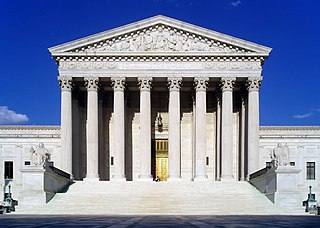
President Barack Obama made two successful appointments to the Supreme Court of the United States. The first was Judge Sonia Sotomayor to fill the vacancy created by the retirement of Justice David H. Souter. Sotomayor was confirmed by the United States Senate on August 6, 2009, by a vote of 68–31. The second appointment was that of Solicitor General Elena Kagan to replace the retired John Paul Stevens. Kagan was confirmed by the Senate on August 5, 2010, by a vote of 63–37.

Brett Michael Kavanaugh is an American lawyer and jurist serving as an associate justice of the Supreme Court of the United States. He was nominated by President Donald Trump on July 9, 2018, and has served since October 6, 2018. He was previously a United States circuit judge of the United States Court of Appeals for the District of Columbia Circuit.
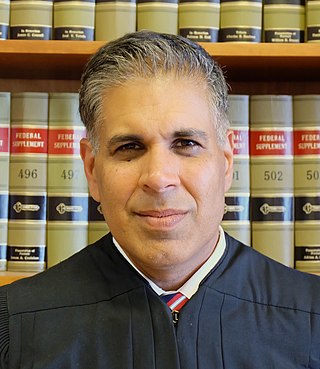
Amul Roger Thapar is an American attorney and jurist serving as a United States circuit judge of the United States Court of Appeals for the Sixth Circuit. He is a former United States district judge of the United States District Court for the Eastern District of Kentucky and former United States Attorney for the Eastern District of Kentucky. He was also President Trump's first Court of Appeals appointment and Trump's second judicial appointment after Justice Neil Gorsuch. Thapar was discussed as a candidate for the Supreme Court of the United States.
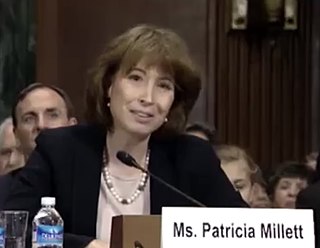
Patricia Ann Millett is a United States circuit judge of the United States Court of Appeals for the District of Columbia Circuit. She formerly headed the Supreme Court practice at the law firm Akin Gump Strauss Hauer & Feld. Millett also was a longtime former assistant to the United States Solicitor General and served as an occasional blogger for SCOTUSblog. At the time of her confirmation to the D.C. Circuit, she had argued 32 cases before the United States Supreme Court. In February 2016 The New York Times identified her as a potential nominee to replace Justice Antonin Scalia.

The nomination and confirmation of justices to the Supreme Court of the United States involves several steps, the framework for which is set forth in the United States Constitution. Specifically, Article II, Section 2, Clause 2, provides that the president of the United States nominates a justice and that the United States Senate provides advice and consent before the person is formally appointed to the Court. It also empowers a president to temporarily, under certain circumstances, fill a Supreme Court vacancy by means of a recess appointment. The Constitution does not set any qualifications for service as a justice, thus the president may nominate any individual to serve on the Court.
U.S. President Barack Obama nominated over 400 individuals for federal judgeships during his presidency. Of these nominations, Congress confirmed 329 judgeships, 173 during the 111th & 112th Congresses and 156 during the 113th and 114th Congresses.

Barbara Lagoa is an American attorney and jurist serving as a United States circuit judge of the United States Court of Appeals for the Eleventh Circuit. Prior to becoming a federal judge, she was the first Latina and Cuban American woman appointed to serve as a justice of the Supreme Court of Florida.
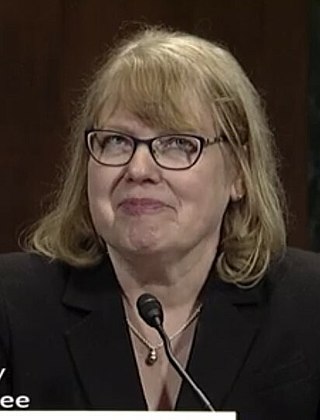
Allison Lynn Hartwell Eid is a United States circuit judge of the United States Court of Appeals for the Tenth Circuit. She previously served as an associate justice of the Colorado Supreme Court.

Joan Louise Larsen is an American attorney serving as a United States circuit judge of the United States Court of Appeals for the Sixth Circuit. She previously was an associate justice of the Michigan Supreme Court from 2015 to 2017.

On March 16, 2016, President Barack Obama nominated Merrick Garland for Associate Justice of the Supreme Court of the United States to succeed Antonin Scalia, who had died one month earlier. At the time of his nomination, Garland was the Chief Judge of the United States Court of Appeals for the District of Columbia Circuit.
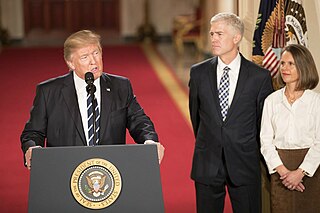
On January 31, 2017, soon after taking office, President Donald Trump, a Republican, nominated Neil Gorsuch for Associate Justice of the Supreme Court of the United States to succeed Antonin Scalia, who had died almost one year earlier. Then-president Barack Obama, a Democrat, nominated Merrick Garland to succeed Scalia on March 16, 2016, but the Republican-controlled U.S. Senate did not vote on the nomination. Majority leader Mitch McConnell declared that as the presidential election cycle had already commenced, it made the appointment of the next justice a political issue to be decided by voters. The Senate Judiciary Committee refused to consider the Garland nomination, thus keeping the vacancy open through the end of Obama's presidency on January 20, 2017.

Amy Vivian Coney Barrett is an American lawyer and jurist who serves as an associate justice of the Supreme Court of the United States. The fifth woman to serve on the court, she was nominated by President Donald Trump and has served since October 27, 2020. Barrett was a U.S. circuit judge on the U.S. Court of Appeals for the Seventh Circuit from 2017 to 2020.
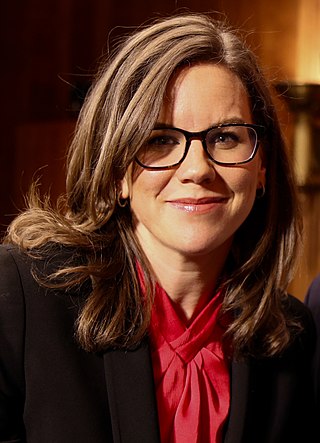
Britt Cagle Grant is an American attorney and judge who is a United States circuit judge of the United States Court of Appeals for the Eleventh Circuit. She is a former Justice of the Supreme Court of Georgia.
Donald Trump, President of the United States from 2017 to 2021, entered office with a significant number of judicial vacancies, including a Supreme Court vacancy due to the death of Antonin Scalia in February 2016. During the first eight months of his presidency, he nominated approximately 50 judges, a significantly higher number than any other recent president had made by that point in his presidency. By June 24, 2020, 200 of his Article III nominees had been confirmed by the United States Senate. According to multiple media outlets, Trump significantly impacted the composition of the Supreme Court and lower courts during his tenure.

Allison Blair Jones Rushing is an American attorney and jurist serving as a United States circuit judge of the United States Court of Appeals for the Fourth Circuit since March 2019.

On September 26, 2020, President Donald Trump announced the nomination of Amy Coney Barrett to the position of Associate Justice of the Supreme Court of the United States to fill in the vacancy left by the death of Ruth Bader Ginsburg. At the time of her nomination, Barrett was a Judge of the United States Court of Appeals for the Seventh Circuit in Chicago, Illinois. The Senate received word from the president on September 29.



